Before I go on about specific fossils, let me explain what the environment may have been like for these critters in the location where I collect. The formation is a marine deposit, and what is now land in this part of the Mid-Atlantic was once covered by oceanic inshore waters. The climate that is now temperate was tropic 65 million years ago. The dinosaurs became extinct at the end of the Cretaceous period about 70 million years ago, and mammals were evolving at a rapid pace. Reptiles, birds, fish and sharks were the dominant vertebrate life forms. In the seas, sharks were the primary predator, and along the coast huge crocodiles roamed eating fish, sharks, and any land animal that they could catch. Sharks and crocodiles preyed on each other! The ancestors of whales and other sea mammals had not taken to the sea yet, so most of the shark's prey consisted of fish, land animals, birds, turtles, sharks, stingrays and crocodiles.
Palaeocene sharks resembled some of todays sharks. Most of them have long been extinct yet their ancestors thrive today. Today, requiem sharks such as bull sharks, dusky sharks, sand sharks and reef sharks are the dominant genera. 65 million years ago, requiem sharks were just beginning to appear in the fossil record. Sand tiger sharks dominated the seas, having the largest number of genera and species of any other type of shark. Stingrays were also common. It was also a time of transition for the megatooth sharks. What is believed by many to be a direct ancestor of the giant white shark commonly known as Megalodon was a shark known as Otodus obliquus. This shark grew to about 35 feet long and had robust dagger like teeth as long as 4". These teeth were versatile with the ability to catch and eat large prey, but also were robust enough to crunch through bone, tough leathery hides and turtle shells.
Teeth like this one from Otodus obliquus came from a shark that was over 30 feet long!
Otodus would dwarf todays largest predatory sharks. There was another shark that arose during this period but soon became extinct (many believe) was the pygmy great white shark, Palaeocarcharodon orientalis. The teeth resembled today's great white sharks, but were much smaller and much more heavily serrated, like a steak knife. These teeth are relatively rare world wide, but can be found in a couple locations in the United States. Most of the specimens for sale in the retail fossil community come from Morocco.
This is my only pygmy great white shark tooth, or Palaeocarcharodon orientalis specimen, that I've found so far. Wave action most likely wore this tooth down. Better quality specimens can be found though, a goal of mine in the future.
Beautiful Palaeocarcharodon orientalis found by Kevin May.
Click on this link to learn more about the pygmy great white shark:
Sand tiger sharks were the most numerous of the Palaeocene epoch. There were many different species, all of them extinct, but some are ancestors of today's sand tiger sharks. Here's a link to a picture of a sand tiger shark: http://animals.nationalgeographic.com/animals/fish/sandtiger-shark.html
You'll notice that the teeth of these sharks are very long, curved and thin. They are perfect for catching and holding fish until they can be swallowed. Each tooth sort of resembles a fish hook! Below is a picture of some of the teeth collected on one trip. You can see the sand tiger teeth in the bottom of the picture.
These fossils were collected during one trip to a Palaeocene location. The bottom two rows are teeth from various species of sand tiger sharks.
Sharks teeth are probably one of the most commonly collected fossils in the world. Why? Well, there are a lot of them out there and because of the tough durable material that nature has crafted them out of (dentine), they preserve very well. Why are there so many sharks teeth in our fossil beds? Modern sharks have rows of teeth behind their current active set of teeth, and these rows are known as files. Sharks continually lose their teeth when they feed, and when they lose a tooth, another one grows behind it to take it's place from the "file", kind of like a conveyor belt. Modern sharks lose several thousand teeth each year and some sharks lose as many as 10,000 teeth per year! Now, imagine that the Palaeocene formation contains sediments that range from 60-65 million years old. That's a five million year range. If there were, say, several million sharks in the region at any given time during that period, multiplied by five million years, multiplied by 10,000 teeth per shark, and if you do the math...well, that's a lot of shark teeth!
You'll notice that the fossil shark teeth come in a variety of colors. It has nothing to do with age other than they've been fossilized. The coloration depends on the mineralization that takes place in and around the tooth. In other words, the minerals in the sediments that the teeth are buried in will influence the color of the fossil during the fossilization process. For example, iron deposits tend to give fossils a reddish brown hue. Modern day shark teeth are almost pure white in comparison.
How do the fossils find their way on to the beach? Imagine a shark losing teeth while feeding. The teeth settle to the bottom of the ocean floor in whatever sediments are on the bottom. After millions of years of being buried, the oceans finally recede and what was once under water is now land. Erosion from weather, rain, wind, and perhaps waves form cliffs. Within those cliffs are our buried fossils. When chunks or boulders fall from the cliffs that contain the fossils, that's their first placement on the beach. Eventually, those boulders or clay blocks erode from wave action, freeing the fossils to take their place within new beach sediments, like sand or gravel.
Here you can see the cliffs containing fossils. Fossiferous material falls from the cliffs and eventually erodes leaving various fossils lining the beach.
Can you find the sharks teeth in these pictures? You can see that you need a sharp eye to spot these fossils that hide between shells, sand and gravel. Here are a couple pictures of Otodus teeth just waiting to be collected amongst beach material.
What other fossils can you find? We find crocodile teeth and bones, crocodile scutes, pieces of turtle shells, shark and fish vertebrae, stingray dental plate fragments (stingray teeth), bird and reptile bones, and sometimes fish teeth. Every now and then you may find a piece of shark cartilage. Shark vertebrae and pieces of cartilage are much more rare than shark teeth because they don't preserve as well as the teeth. There are also various invertebrate fossils in the form of sea shells, internal and external molds. Some are snail like gastropods. You may also find different species of clams and oysters.
This is a large chunk of a fossilized turtle shell.
If you're lucky you may find crocodile a tooth. Steven Ferguson hit the jackpot when he found a block of clay containing an entire crocodile skull (top picture)! The crocodile skull after it was prepped - clay and other rock removed from the fossil (lower picture).
So why collect fossils? It's a great way to have fun outdoors. In my case, it's a hobby that both my daughter and I enjoy that we can spend quality time together. You can find many of nature's treasures and often some have monetary value. Most of the time when I beach collect, it's as if you get lulled into a trance by the slapping of gentle waves on the shoreline as you drift into prehistoric past. It's relaxing and most of all just plain fun!
Here's a huge Otodus tooth found by my daughter. Notice the near perfect quality of this tooth even after 65 million years of fossilization. The tip of the tooth shows what is known as "feeding damage" that occured while this animal was feeding on another animal. Perhaps the tooth bit down on a turtle shell, or a crocodile bone? It's a mystery that adds to the mystique of this fossil.
Finally, you may find these types of fossils where you live, or perhaps different fossils. You may find them in a beach, or along a road cut, or perhaps a river or creek bed, or a geologic formation exposed in a field. To find fossils near you, look up your state or territorial government and find the department or agency responsible for geology. You should be able to get some information about what formations contain fossils in your area and may able to obtain a geologic map of formations. But the best way to find fossils is to join a fossil club or a fossil society near you. They will teach you where, what, how, when and why as pertaining to collecting fossils. And who knows? Perhaps you'll find something new to science! Many of todays paleontological finds were the result of amateur collectors. In future articles, I'll discuss other formations and types sharks that can be found, including the massive giant great white shark, Carcharocles megalodon.
For more information about fossils including sharks teeth, please visit the following links:
The above links will help you learn more about fossils, their formations, identification of your finds, and also get to know people in the fossil collecting community.


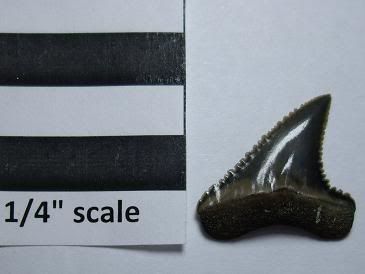
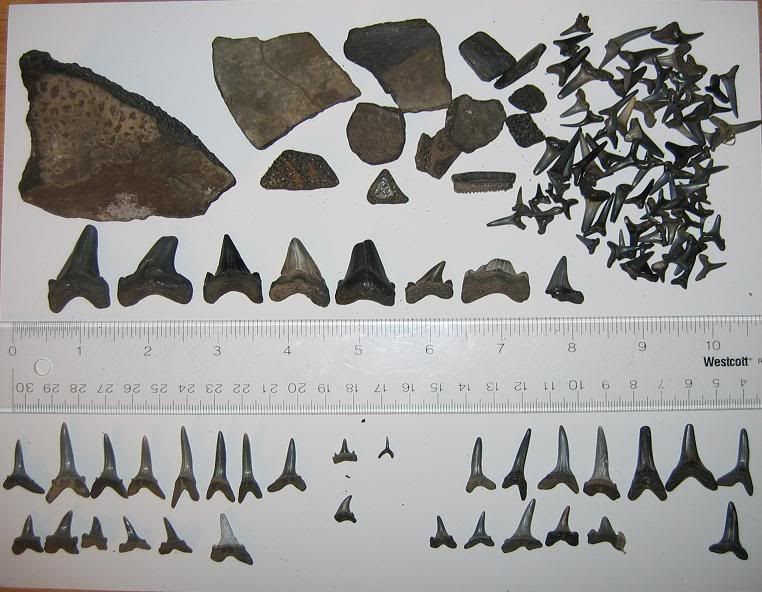
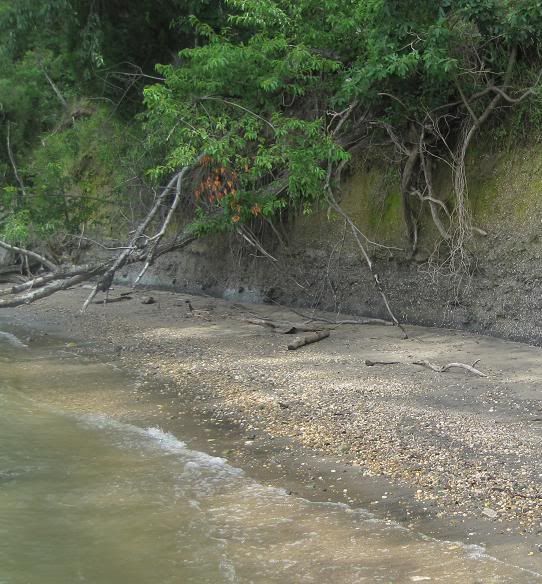



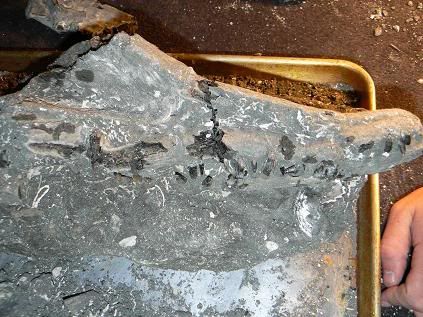
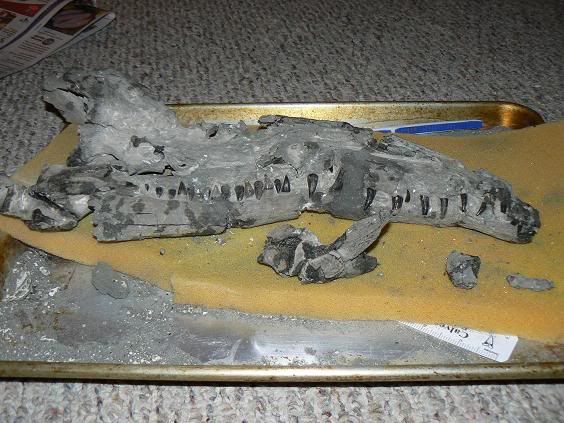
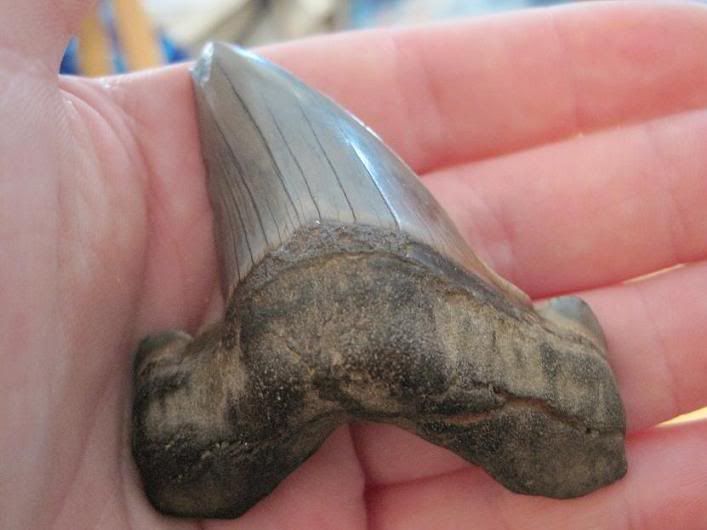
No comments:
Post a Comment